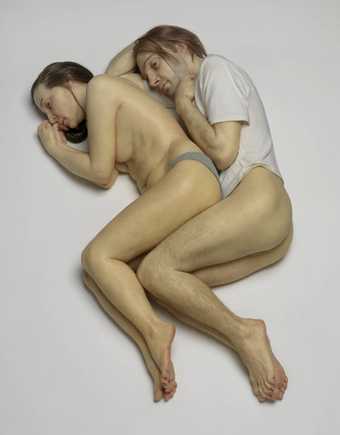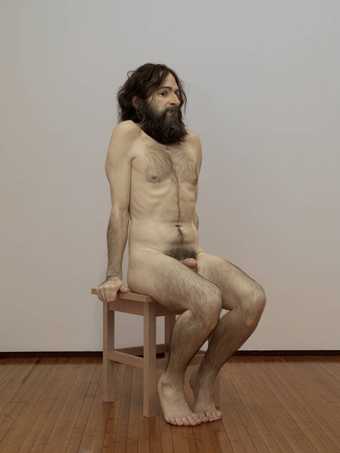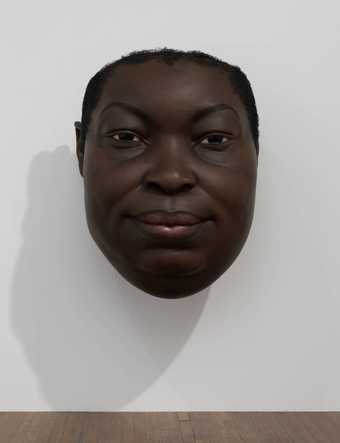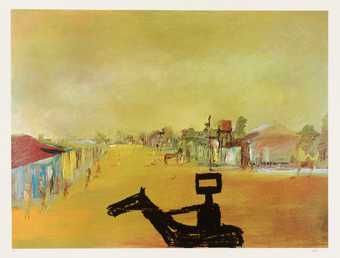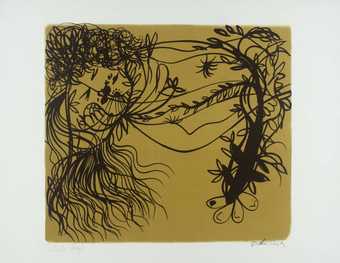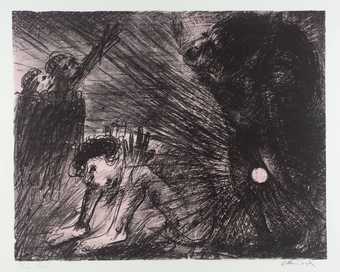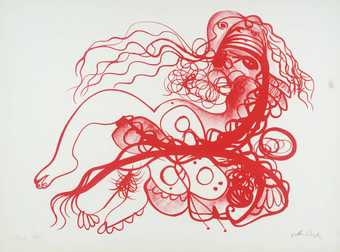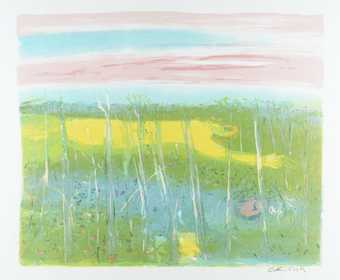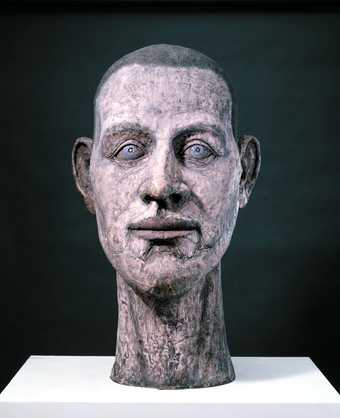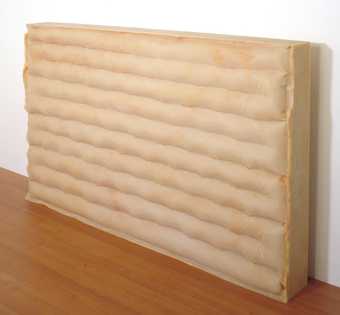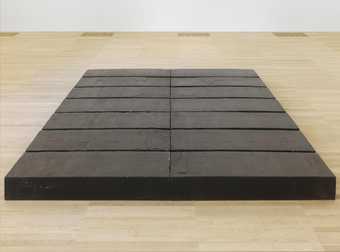
Not on display
- Artist
- Ron Mueck born 1958
- Medium
- Aluminium, fibreglass, silicone rubber, polyurethane foam, polyester resin, acrylic fibre and fabric
- Dimensions
- Unconfirmed: 2019 × 648 × 991 mm
- Collection
- Tate
- Acquisition
- Purchased 1998
- Reference
- T07445
Summary
Ghost 1998 is a very large sculpture of a teenage girl wearing a dark blue swimming costume. Over two metres tall, the long-legged figure seems to lean awkwardly against the gallery wall, her arms hanging down by her sides with her hands and their curled fingers touching the wall behind her. She has brown hair tied in a loose ponytail at the back of her head, and her gaze is directed downwards and to her right. The sculpture is completed in a highly detailed and realistic manner, with small spots visible on the teenager’s face and light hairs on her arms and upper lip. It is displayed on a large white plinth and is affixed to the gallery wall by an aluminium hook located at the base of the figure’s spine.
This work was created by the London-based Australian artist Ron Mueck in 1998, and took around three months to make. Mueck conventionally works from photographs rather than life models, and begins by producing a series of sketches and clay maquettes of his subject before creating a plastic mould for the sculpture. The head, arms and upper chest of Ghost are cast in silicone rubber, while the lower half of the body is cast in fibreglass and polyester resin, with acrylic paint and washes added to the surface. The figure wears a Lycra fabric swimming costume made by the artist’s wife and a purchased wig, with additional acrylic fibre hairs added to the figure’s skin individually using a needle.
The uneasy posture of the figure in Ghost and her downward gaze, which seems to avoid eye contact with the viewer, are suggestive of the bodily discomfort often associated with adolescence, especially given the exposure of her form in the swimming costume. Furthermore, the heightened scale of the girl may be seen to echo the way in which the teenager feels anxious at being the subject of others’ attention. As the curator Susanna Greeves claimed in 2003, ‘Ghost is the embodiment of teenage self-consciousness, the projection of a stage at which our bodies become suddenly large and strange and acutely embarrassing to us’ (Greeves and Wiggins 2003, p.59). The title Ghost can be seen in ironic terms, as the large figure is a far from spectral presence within the gallery, yet it may also refer to the fact that the girl seems to want to disappear from the gaze of those around her.
Mueck was born in 1958 in Australia to German parents, both of whom were toymakers, and has lived and worked in the UK since 1986. Before he began to exhibit his sculptures, he made puppets and models for children’s television programmes, feature films and adverts, a career that included working in the mid-1980s with the celebrated American puppeteer and director Jim Henson (1936–1990) on series such as Sesame Street and The Muppet Show and on the film Labyrinth (1986). In 1996 Mueck began creating highly realistic sculptures of the human figure that often evoke uncanny associations. Pinocchio 1996, which depicts a small boy in white underpants, was part of an installation by the Portuguese artist Paula Rego (born 1935), who is also Mueck’s mother-in-law, that featured in the group exhibition Spellbound: Art into Film, Film into Art held at the Hayward Gallery in London in 1996. Impressed by Pinocchio, the collector Charles Saatchi commissioned Mueck to make three more sculptures, including Dead Dad 1996–7, a half-sized male corpse lying on its back. This was displayed in the group show Sensation: Young British Artists from the Saatchi Collection at the Royal Academy of Arts, London, in 1997, an event considered to be Mueck’s debut as an exhibiting artist. Subsequent sculptures have included the giant crouching figure Boy 1999 (Aarhus Kunstmuseum, Aarhus), installed in the Millennium Dome in London in 2000, and Spooning Couple 2005 (Tate AR00033), which features two intertwined figures.
In a 2009 correspondence with the curator David Hurlston, Mueck explained his move from film, television and advertising and into a formal artistic career as follows:
I had always made things for my own amusement but mostly I was creating things to make a living. The models I had made always seemed like pleasing objects in their own right, it was just that they had been created for another purpose … these [new] pieces had no other reason for being and it seemed that was ok.
(Quoted in Hurlston 2010, p.27.)
Mueck’s work may be seen within the context of hyper-realism, a term first employed in the early 1970s to describe paintings and sculptures, including the lifelike figures made by the American artists Duane Hanson (1925–1996) and Charles Ray (born 1953), that emphasise a highly precise but also heightened version of reality.
Further reading
Susanna Greeves and Colin Wiggins, Ron Mueck, exhibition catalogue, National Gallery, London 2003, p.59, reproduced p.61.
Ron Mueck, exhibition catalogue, National Galleries of Scotland, Edinburgh 2006, reproduced pp.13–15.
David Hurlston, Ron Mueck, exhibition catalogue, National Gallery of Victoria, Melbourne 2010, p.69, reproduced p.138.
Richard Martin
July 2015
Supported by Christie’s.
Does this text contain inaccurate information or language that you feel we should improve or change? We would like to hear from you.
Display caption
Australian born, Ron Mueck first came to public attention during the Royal Academy's 1997 Sensation exhibition. He has been living in Britain for sixteen years and began his career as a puppet maker. He is currently producing figurative sculpture in a hyper-realist style.
Mueck's simulations of human subjects possess an eerie exactitude. He bases them on friends and relatives but does not directly cast from his subjects. Instead he makes works in fibreglass and silicone from maquettes modelled in clay. The distorted size and awkward posture often indicate the subject's emotional state. Ghost 1998, represents a seven-foot girl. Her enlarged scale and uneasy demeanour emphasise a sense of adolescent anxiety.
Gallery label, August 2004
Does this text contain inaccurate information or language that you feel we should improve or change? We would like to hear from you.
Explore
- emotions, concepts and ideas(16,416)
-
- emotions and human qualities(5,345)
-
- anxiety(1,028)
- formal qualities(12,454)
-
- visual illusion(118)
- clothing and personal items(5,879)
-
- swimming costume(102)
- actions: postures and motions(9,111)
-
- standing(3,106)
- girl(1,079)
- birth to death(1,472)
-
- youth(193)
You might like
-
Ron Mueck Spooning Couple
2005 -
Ron Mueck Wild Man
2005 -
Ron Mueck Mask III
2005 -
Sir Sidney Nolan Mansfield
1978–9 -
Arthur Boyd Hammock Lovers
1970 -
Arthur Boyd St Francis Preaching Naked
1970 -
Arthur Boyd Butterfly Man (Red)
1970 -
Arthur Boyd Nebuchadnezzar
1972–4 -
John Davies Head with Blue Eyes
1983–4 -
Rachel Whiteread Untitled (Air Bed II)
1992 -
Rachel Whiteread Untitled (Floor/Ceiling)
1993 -
Rachel Whiteread Untitled (Floor)
1994–5 -
Chris Ofili CBE Double Captain Shit and the Legend of the Black Stars
1997 -
Jake Chapman, Dinos Chapman Disasters of War
1993 -
Sarah Lucas The Old In Out
1998

